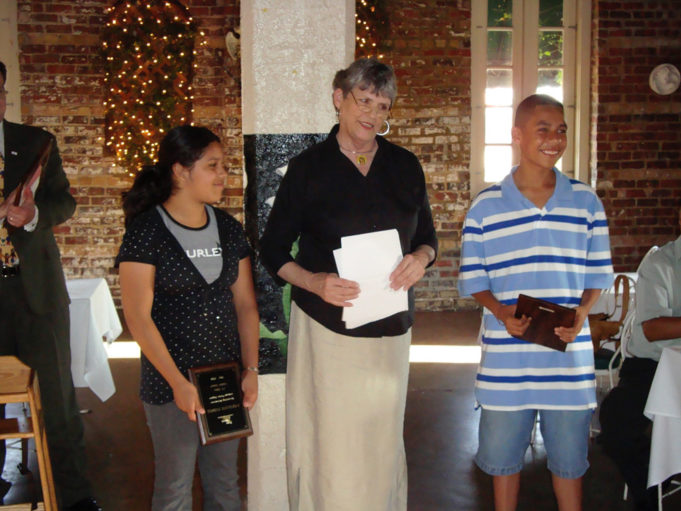What if I told you about a school that even in the midst of COVID-19, which has caused such a mess in education, has continued to fulfill its mission of teaching students? Not only that, it has become a one-stop location for social services for its community, providing food for the families of students and helping with the psychological and social needs of its students. And what if I told you that very exemplary school was right here, in the much-maligned Fort Worth ISD? Would you think I was lying, dealing in fake news, as he-who-should-no-longer-be-named once coined it?
It’s all true, though. I am speaking of the International Newcomer Academy on Camp Bowie that services just-arrived immigrant students. I know from experience how great a school it is. For 17 years, from 1996 to 2013, I taught English-as-a-Second Language at the Amon Carter-Riverside High School Language Center. When I first started there, we taught the newcomers ourselves, and I have to admit teaching that bunch was tons of fun. Those students came eager to learn English, and that class had to be super active to keep their attention. They kept me on my toes, for sure.
A few years later, INA took over teaching the newcomers for the district. At first, I was not happy. I frankly resented it. I missed the excitement of teaching newcomers. After some time, I changed my mind. The truth was, I was never a great newcomer teacher. I was always better with the ones who had been in school at least a year. What really changed my mind is that every year, my students from INA would get better and better. Also, during professional development, I got to see first-hand the incredible INA teachers. I was always struck by their across-the-board professionalism, but not only that. They all had an incredible passion for teaching, especially teaching just-arrived newcomer students. They wanted not to just teach them, but to make a safe place for their students, some of whom were refugees and had been traumatized in their home countries by war and violence.
Fast-forward to 2021 and, without exaggeration, that exemplary school is in mortal danger. This past year, because of COVID-19, we’ve all been schooled in the saying, “Those not at the table are on the menu.” At January’s Fort Worth ISD school board meeting, we sadly learned it once again.
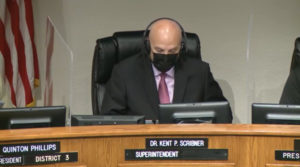
Courtesy YouTube
There, Superintendent Dr. Kent Scribner announced a number of changes that will lead to the relocation of students and staff. Fort Worth’s paper of record, The Fort Worth Star-Telegram, dutifully reported the next day that the district will have “one new central office” . . . “inside of a district building at 7000 Camp Bowie Blvd., the former site for the ALA program, Scribner said.” And then added that the building “will need to be remodeled.” ALA stands for Applied Learning Academy and is a middle school. The article goes on to explain that it will move into the Rosemont Sixth Grade Center. The International Newcomer Academy is housed in the same location albeit at a different address, and it is not even mentioned in the article, though it was mentioned at the meeting. I guess to the Star-Telegram, INA is not a side issue. It just doesn’t exist. The article goes on to explain that in the past year, the district has conducted a fire sale, selling “18 underused properties, including the 80-year-old Farrington Field as part of an effort to save money, estimating it could generate $60 million” and, of course, the administration building on University, necessitating the move to the campus on Camp Bowie. “One of the district’s major goals . . . is to transition out of all of its sold properties without buying new properties.”
It certainly appears the district is in financial straits. So is INA’s move from Camp Bowie to wherever done for financial reasons? According to Chief Academic Officer Jerry Moore, “This decision is a determination of what is best for children, and it is not impacted by any District finances.”
When districts insist they are only doing “what is best for children,” it’s a good idea for all of us to be somewhat skeptical. As I explained above, I worked for the district when newcomer students went immediately to their home schools, and that was not better for them. Having stated this, the district cannot come back later to say it must make the move because of finances.
Fluent in bureaucratese, Moore “explained” the district’s reason for splitting up INA and taking over its building, “The decision to utilize the Academy on Camp Bowie as the new District Administration building was the result of an extensive study of our District facilities. This building was a renovated shopping building and part of our realignment efforts were to get all students into buildings intended to serve as schools. As a District, we continuously look at each of our initiatives and programs that support our students not only academically but also through a lens of safety, social & emotional, [sic] and access.”
Is the above just verbiage or is Jerry Moore suggesting the Academy on Camp Bowie that has served students for two decades is somehow unsafe? And that that’s fine for administration’s staff but not students?
As well as being banished from its site for the past 20 years, the district’s future plans for INA are, to put it mildly, vague. There was some discussion at the school board meeting of scattering the INA program to four campuses throughout the city, so that students would be closer to their home schools and not spend so much time on buses. But a central question for me is why does Applied Learning Academy, which is housed in the same building, know where it’s going now but not INA?
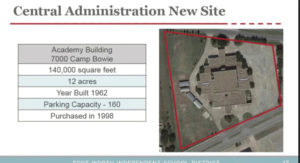
Courtesy FWISD
As an INA teacher who wishes to remain anonymous explained, “The biggest concerns we have is that the district had a plan ready to go for ALA (Applied Learning Academy) and the plan for us and our English Language Learner Newcomer students was not figured out nor thought out. Why would they not be more or even just equally decisive and concerned about the school with highly skilled and innovative ESL professionals teaching our newcomer immigrant and refugee students during a highly impactful year in their academic careers?”
My take on it: The reason the district has a plan at the ready for ALA but not INA is simple. ALA’s students’ parents vote, and the district and board respect that political power. INA parents, on the other hand, are not at the table but on the menu because generally they are not citizens and cannot vote. The school board seized this opportunity because they see powerlessness and, most of all, tons of parking.
You might not know that the parking at the present administration building on University Drive has been an ongoing nightmare for years. It’s been a never-ending source of grumbling for teachers, staff, and administrators for decades. So I can just imagine those in charge looking over at that Camp Bowie campus and just salivating, looking at all that parking. From the administration’s point of view, why wouldn’t they go for it? The parents are powerless, and the parking is great.
So, did the district, in its infinite wisdom, get buy-in from stakeholders? Did they talk to the excellent cadre of dedicated teachers at INA who, one suspects, might be moving to those four schools in the future? In short, did they treat them like the professionals they are? When I asked Jerry Moore that question, he admitted that only the principal had been told beforehand.
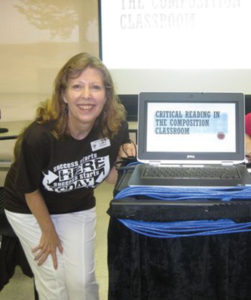
Angela Chilton
Adding insult to injury, INA teachers learned of their school’s fate when Dr. Scribner made the announcement that Tuesday evening at the board meeting. One INA teacher shared with me that when they found out the news, their “hearts fell to the floor . . . and the next day was a day of grief” for all INA teachers. That morning, they attended a meeting with administrators who made it clear the move was a fait accompli. There was nothing the teachers could do about it.
Not only was it wrong to treat these fine professionals in this manner, it also didn’t make any sense. As one INA teacher put it, “In my opinion, in order for us to establish a ‘new program’ or new format of our school, we should’ve been planning and having conversations at least a year before. We aren’t just a regular campus being moved and separated … the planning focus groups and design team are supposed to be meeting in February and March. They have allocated less than two months at this point, since we still haven’t heard back, to scramble and decide the fate of our school, a school that provides essential supports . . . for our newcomer students to receive a strong foundation during their first year in the country.”
Regardless of the district’s moves, INA at its current site is worth maintaining. It’s not just old ESL teachers, like me, that admire it. Fort Worth’s International Newcomer Academy is nationally recognized for excellence in teaching English to newcomers to our country. Its excellence has been documented in any number of scholarly books and articles.
For example, in English Language Learners and the New Standards, Aida Walqui, a well-respected expert on teaching English to newcomers, writes in the acknowledgment that she “extends her appreciative thanks to many teachers she has worked with, especially colleagues at International Newcomer Academy in Fort Worth, Texas.” In another book edited by Aida Walqui, Amplyfiying the Curriculum, each chapter describes an exemplary lesson for these immigrant students in different content areas. Two of the chapters are written or co-written by present or former INA teachers.
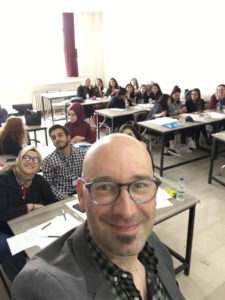
Courtesy Steve Przymus
INA is also home to the amazing Faiha Al-Atrash, its Parent and Community Liaison. With no prompting from me, multiple people I talked to about this story brought up Faiha. And why not? She provides wrap-around services for INA students and their families. According to Dr. Steve Przymus, “This year alone . . . Faiha Al-Atrash has collected close to $100, 000 in contributions from the community.” She also provides clothing and backpacks for students, has established a food bank on the campus, and was instrumental in getting JP & Associates, a local real estate agency, to present an annual college scholarship to two high school seniors who were former INA students. She was recently featured in the Star-Telegram’s Hometown Heroes series. This outreach would not be possible if INA was scattered at different locations.
I’m not alone in doing a double take at the district’s thoughtless dismantling of a great program. Former Fort Worth ESL teacher and language center team leader Lucinda Channon messaged me that she thought, “it is a terrible idea to dismantle” INA. “When I got to Paschal [High School], I learned that it was really good for the students to go to INA first . . . since everything about INA was set up to support the beginning students.”
Another former ESL teacher, Adaire Fisher, who taught at J.P. Elder Middle School, noted that once INA took over teaching the newcomers, the “students were ready to transition to ‘regular’ classes and outperform students in the greater school within two years. Clearly . . . [INA] has had a profound effect on students new to English. Their rate of growth in acquiring a new language has been astounding.”
As former INA teacher Kip Wright put it succinctly, “INA is the best Fort Worth ISD school,” and moving newcomers into regular schools is “throwing them to the wolves.”
One reason the district thought it an opportune time to tear INA apart is the numbers at INA have decreased precipitously the past few years because of Trump’s immigration policies and, lately, due to COVID-19 restrictions. Currently, there are 238 students there, historically, a very low number. Surely, with a new administration, a world-wide pandemic causing economic hardship, and climate change wreaking havoc, more immigrants, documented and undocumented, will come to the U.S. INA at Camp Bowie has handled as many as about 800 students not very long ago and would be the best place for a new influx of immigrant students to go.
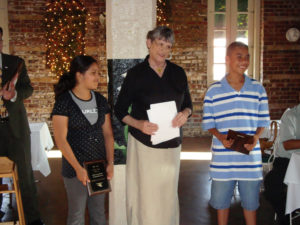
That story illustrates that while Fort Worth ISD likes to say it cares about all students, a sizeable number of administrators simply want immigrant students gone. A case in point is the language centers, where the students go after INA in order to transition into the regular program. During most of the time I worked for the district, language centers had a great cadre of teachers. As numbers have dropped in the past few years, some schools have lost their language centers, my old school, for instance. Now, the language center program is falling apart. Some schools still have good ones, but it’s a shadow of its former self. I consider that a cautionary tale for what could happen to INA if it is broken apart and scattered to different campuses, where principals might not be so supportive of it.
INA teachers understand this. After being unceremoniously told of their fate, some met after school and planned how to challenge this bonehead move by the district’s head honchos. One plan was to find ex-INA students who have done well and have them speak to the school board at its Feb. 23 meeting. I have no idea if such a brave plan will work. The powers that be in the district want everyone to believe this is a done deal.
If you’re interested in tilting at windmills, and who isn’t, you can call 817-814-1956 by 5:30 p.m. Tuesday to speak during the public comment section of the meeting. Because it’s a virtual meeting, they’ll give you instructions on how to do a Zoom call that will be limited to three minutes. Good luck.



